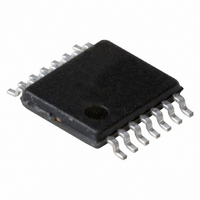P87LPC760BDH,112 NXP Semiconductors, P87LPC760BDH,112 Datasheet - Page 26

P87LPC760BDH,112
Manufacturer Part Number
P87LPC760BDH,112
Description
IC 80C51 MCU 1K OTP 14-TSSOP
Manufacturer
NXP Semiconductors
Series
LPC700r
Datasheet
1.P87LPC760BN112.pdf
(56 pages)
Specifications of P87LPC760BDH,112
Program Memory Type
OTP
Program Memory Size
1KB (1K x 8)
Package / Case
14-TSSOP
Core Processor
8051
Core Size
8-Bit
Speed
20MHz
Connectivity
I²C, UART/USART
Peripherals
Brown-out Detect/Reset, LED, POR, WDT
Number Of I /o
12
Ram Size
128 x 8
Voltage - Supply (vcc/vdd)
2.7 V ~ 6 V
Oscillator Type
Internal
Operating Temperature
0°C ~ 70°C
Processor Series
P87LPC7x
Core
80C51
Data Bus Width
8 bit
Data Ram Size
128 B
Interface Type
I2C/UART
Maximum Clock Frequency
20 MHz
Number Of Programmable I/os
12
Number Of Timers
2
Operating Supply Voltage
2.7 V to 6 V
Maximum Operating Temperature
+ 70 C
Mounting Style
SMD/SMT
3rd Party Development Tools
PK51, CA51, A51, ULINK2
Minimum Operating Temperature
0 C
Lead Free Status / RoHS Status
Lead free / RoHS Compliant
For Use With
OM10063 - PROGRAMMER LPC700 P76XLCPOM10050 - EMULATOR LPC700 PDS76X
Eeprom Size
-
Data Converters
-
Lead Free Status / Rohs Status
Lead free / RoHS Compliant
Other names
568-1015-5
935271146112
P87LPC760BDH
935271146112
P87LPC760BDH
consumption, in a manner similar to Idle mode. By dividing the clock,
Philips Semiconductors
CPU Clock Modification: CLKR and DIVM
For backward compatibility, the CLKR configuration bit allows setting
the P87LPC760 instruction and peripheral timing to match standard
80C51 timing by dividing the CPU clock by two. Default timing for
the P87LPC760 is 6 CPU clocks per machine cycle while standard
80C51 timing is 12 clocks per machine cycle. This division also
applies to peripheral timing, allowing 80C51 code that is oscillator
frequency and/or timer rate dependent. The CLKR bit is located in
the EPROM configuration register UCFG1, described under EPROM
Characteristics
In addition to this, the CPU clock may be divided down from the
oscillator rate by a programmable divider, under program control.
This function is controlled by the DIVM register. If the DIVM register
is set to zero (the default value), the CPU will be clocked by either
the unmodified oscillator rate, or that rate divided by two, as
determined by the previously described CLKR function.
When the DIVM register is set to some value N (between 1 and
255), the CPU clock is divided by 2 * (N + 1). Clock division values
from 4 through 512 are thus possible. This feature makes it possible
to temporarily run the CPU at a lower rate, reducing power
the CPU can retain the ability to respond to events other than those
that can cause interrupts (i.e. events that allow exiting the Idle
mode) by executing its normal program at a lower rate. This can
allow bypassing the oscillator startup time in cases where Power
Down mode would otherwise be used. The value of DIVM may be
changed by the program at any time without interrupting code
execution.
2002 Mar 07
Low power, low price, low pin count (14 pin)
microcontroller with 1 kbyte OTP
CRYSTAL: MEDIUM FREQUENCY
CRYSTAL: HIGH FREQUENCY
CRYSTAL: LOW FREQUENCY
INTERNAL RC OSCILLATOR
EXTERNAL CLOCK INPUT
POWER MONITOR RESET
FOSC2 (UCFG1.2)
FOSC1 (UCFG1.1)
FOSC0 (UCFG1.0)
POWER DOWN
Figure 18. Block Diagram of Oscillator Control
CLOCK SELECT
CLOCK
SOURCES
SELECT
CLOCK
XTAL
OUT
23
Power Monitoring Functions
The P87LPC760 incorporates power monitoring functions designed
to prevent incorrect operation during initial power up and power loss
or reduction during operation. This is accomplished with two
hardware functions: Power-On Detect and Brownout Detect.
Brownout Detection
The Brownout Detect function allows preventing the processor from
failing in an unpredictable manner if the power supply voltage drops
below a certain level. The default operation is for a brownout
detection to cause a processor reset, however it may alternatively
be configured to generate an interrupt by setting the BOI bit in the
AUXR1 register (AUXR1.5).
The P87LPC760 allows selection of two Brownout levels: 2.5 V or
3.8 V. When V
detector triggers and remains active until V
above the Brownout Detect voltage. When Brownout Detect causes
a processor reset, that reset remains active as long as V
below the Brownout Detect voltage. When Brownout Detect
generates an interrupt, that interrupt occurs once as V
from above to below the Brownout Detect voltage. For the interrupt
to be processed, the interrupt system and the BOI interrupt must
both be enabled (via the EA and EBO bits in IEN0).
When Brownout Detect is activated, the BOF flag in the PCON
register is set so that the cause of processor reset may be
determined by software. This flag will remain set until cleared by
software.
COUNT
RESET
OSCILLATOR STARTUP TIMER
10-BIT RIPPLE COUNTER
(UCFG1.3)
CLKR
DD
drops below the selected voltage, the brownout
COUNT 1024
COUNT 256
(DIVM REGISTER)
CLKR SELECT
DIVIDE-BY-M
AND
1/ 2
DD
P87LPC760
is returns to a level
Preliminary data
DD
SU01167
DD
crosses
CLOCK
remains
CPU














